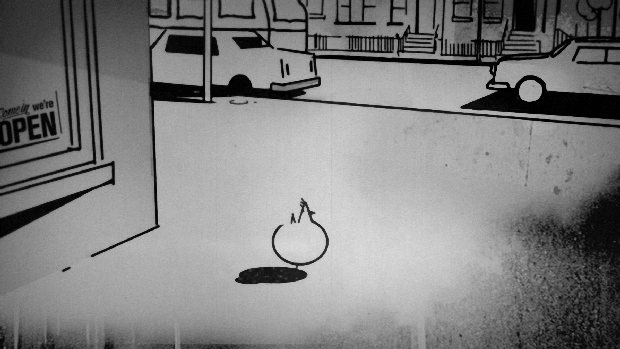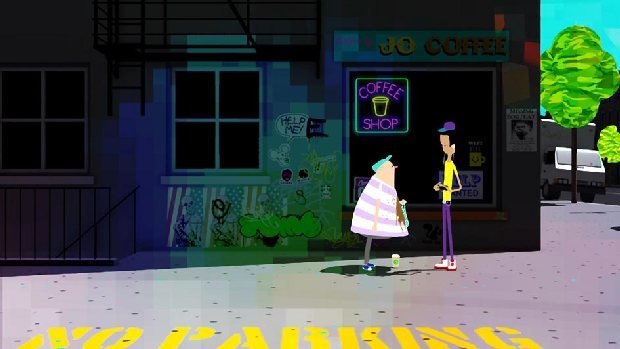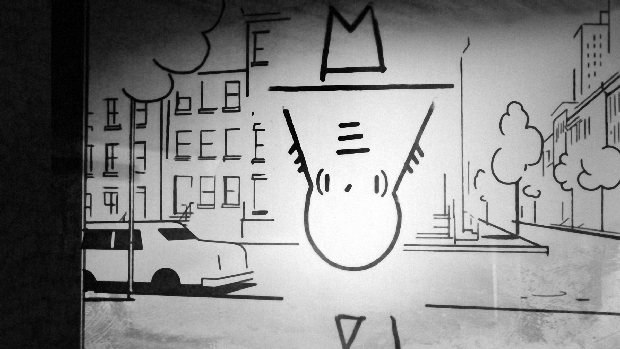The director discusses the genesis and challenges of making his oscar-nominated short film.
Check out more about A Morning Stroll in the 2012 AWN Oscar Showcase.
He was inspired by a quirky short story about a chicken out for a walk in the middle of a big city. Director Grant Orchard set off to make a film comprised of sections exactly 1 minute long. His producer, Sue Goffe, knew it would turn out otherwise. With good reason. In any event, the final result of their collaboration is a unique and compelling film, something akin to “poultry in motion.” Yes, I couldn’t resist. Grant discusses the genesis and challenges of the project.
Dan Sarto:Has it hit you yet that your film has been nominated for a BAFTA and an Oscar? What was your initial reaction? Grant Orchard: Yes it’s hit me. It's hit me straight in my fat, slack-jawed face. You know in Austin Powers when Mike Myers hypnotizes Christian Slater and demands that he gets him some orange sherbet? Well my face looks exactly like Christian Slater’s at that point- but all the time. (p.s. that’s an Oscar nominated quality cultural reference). DS:This film grew into something much larger than you originally planned. It also has a unique concept. How did this film begin – what is the genesis of the story and what shaped your path to finished film? GO: I read a short story that was in a book edited by Paul Auster called True tales of American Life. There was a rather lovely section in it where a woman sees a chicken walk down a busy city street. I don't know why, but that image stuck in my head. It felt like one of those urban myths people recount that then get exaggerated with each re-telling, like Chinese whispers, into something more and more outlandish. I guess that was my initial thought process too. I kept on thinking about different variations on that theme.
Also around that time a friend of mine put me onto the work of Raymond Queneau who wrote a magnificent book called Exercises in Style. It re-counts the mundane story of a man on a bus who sees two people arguing. He writes this page long story in 99 different styles. I really enjoyed the rhythm of it, and the more he retold it the more engaging the whole book became.
So I suppose over a few days all that coalesced in my head, made me excited and got me talking to STUDIO AKA about making it into a film. At this stage I was determined to make each section exactly one minute long, but as the process went along the duration expanded. I think Sue Goffe, my producer knew this. As a rule of thumb, however long a director thinks a project will take, and how many people they need to make that project happen, she multiplies it by three. Very wise.
DS:What was the most difficult story challenge? Production challenge?
GO: Apart from the length of time it took, which was just under 2 years due to commercial commitments, I suppose the most difficult aspect of the film was the 2009 section with the I-phone game. It always seemed a tricky one to get right. I wanted to use it as a distraction for the main character, and simultaneously distracting for the audience.
Ideally I wanted to stay on the game for around a minute to two minutes, mirroring what happens in real life when someone shows you an app or game on their mobile phone. You become engrossed and you disengage with what’s happening around you; and then after lord knows how long you realize you’ve been looking at something completely inane for far too long.
In the end we stayed on it for around 30 seconds, but I always find it’s neither fish nor fowl. Saying that though, it must have registered with people, because were constantly getting asked when or not we’re making the app.
DS:How does this film differ from your previous work?
GO: I think it differs from my previous films because it was a chance to make something in 3D. I’ve usually tinkered with personal projects on my own and done them in 2D because that’s my bag, and that’s what I’m comfortable with.
I’ve been directing 3D projects commercially for a long time now, but I’m useless with 3D software. I just can’t get my head round it. Luckily there’s an enormously talented group of people at STUDIO AKA who know their CG onions. So to get an opportunity to work with them on a longer project was brilliant, and not something I wanted to screw up. DS: Can you tell us about your animation process and how you made the film?
GO: After the initial idea I tend to do a little design, and then go straight to making an animatic; the rougher the better. I like that part to be really quick so I can see the film fleshed out as soon as possible. I don’t like getting too precious with the boarding because I always find that if you do you start getting too attached to certain frames, which are invariably the ones that are a bit duff. Also, I’m a bit lazy and can’t be bothered to spend ages working on animatic frames, that part is when you first see your film, and I don’t want to be bored of it at that stage. That stage is exciting!
After that I carry on working on the designs. Usually I apply certain rules to a personal project that help me focus and stop me from repeating myself. No parameters, but a principle that allows me not to dwell on the possibilities of limitless options. For example I made a series called Love Sport, where anything was possible as long as all the characters were rectangles with no feature. As soon as I’d dictated that the series kind of designed itself. For A Morning Stroll the rule that applied was that all three chapters had to have the same composition, camera move and length. This meant that once I’d designed the first section the others had to follow suit. I only broke this rule once, when in the last section I decided to make the chicken completely real. After a while it just felt wrong, in fact Philip Hunt at STUDIO AKA mentioned it; we took it back to the original stylized shape and covered it in real feathers and it felt right again.
After that I blocked out the job with STUDIO AKA layout artist Anna Kubik, who did a grand job shaping the sets and pace. She also organized allocating the work to various people within the company. Due to having no funding for the film, Sue Goffe organized a process where anyone in between commercial work would go to see Anna and be given a section of the film to work on. They might have had two days or two hours spare, but incrementally we got it made. Phew!
DS: How does your film compare to the other nominated films?
GO: I don’t know. I’ve only seen “Sunday” which I thought was gorgeous. I managed to see that because we were both premiered at Annecy last year. The rest I am looking forward to seeing when I’m out to L.A. I think we’ll all be doing a few Q&A sessions, and I’m looking forward to seeing them on the big screen.
DS:What part of your work gives you the most sense of satisfaction?
GO: Well it’s not seeing the finished project, which always fills me with a peculiar sense of unease - like I’ve missed something. I think you always feel there’s an element that could have been better, and that’s probably over familiarity.
I do like the animatic stage, that’s always fun, but I’m picking one part of a process that as a whole I love. So to answer your question, I pretty much find the whole shebang satisfying.
DS: What are your stylistic influences? GO: Comic artist Chris Ware. Painter John Currin. Ye olde pioneering animator Emile Cohl and Woody Allen. DS:What are you working on next?
GO: I’m currently working on a series of American commercials with a super-talented designer named Chris Gray. Also I’m developing a pre-school show. There’s a small abstract piece of animated erotica that I’m finishing off, and I’m working on another short called First Class. It’s based on a short story by the amazing Craig Taylor. He’s a Canadian who wrote a book called One Million Tiny Plays about Britain. One of them is about a father and daughter who sit in a first class train carriage without the proper tickets. Sounds terribly ordinary and dull but it’s not. It’s beautiful.
Sue Goffe, my producer, has managed to get the rights to it. I’ve designed it so I can do it pretty much myself, without budget. It might take me a couple of years of chipping away at it but it’ll be worth it.
Dan Sarto is Publisher of AWN.
Dan Sarto is Publisher and Editor-in-Chief of Animation World Network.











